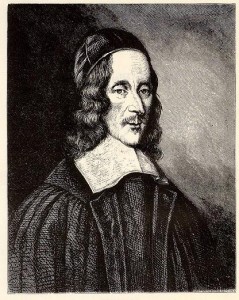
The milky way, the bird of Paradise,
Church-bells beyond the stars heard, the soul’s blood,
The land of spices; something understood.
– Description of prayer from George Herbert’s poem Prayer (I)
Reflection
I certainly didn’t expect it. If someone had told me that a seventeenth-century poem called Prayer would capture the imaginations of my undergraduate British literature class, I’d have chuckled gently. My students that semester were thoughtful and full of goodwill, but they didn’t seem extraordinarily interested in seventeenth-century Anglican theology.
In fact, I taught George Herbert’s Prayer (I) mainly because I was also struggling to write my dissertation on Herbert and Donne at the time. I couldn’t resist sneaking a day for each of them into my syllabus, and I hoped that my research and teaching could dovetail at least for those two class periods.
But to my surprise, our classroom conversation about Prayer (I) was one of the most successful discussions all semester. As I read out quotations from the poem and asked what each image meant, thirty students tossed out insights with a fascination that surprised me.
They seemed compelled by Herbert’s language, intrigued by what it would mean for prayer to be “the bird of paradise,” “the soul’s blood,” or “church-bells beyond the stars heard.”
Later, I realized that this language was likely different from the way twenty-first century readers usually speak about prayer, more striking. Perhaps that was one reason my students found it so compelling. I also realized that Herbert’s language still had a lot to teach me about prayer.
I’ve been praying as long as I can remember. Longer, actually. Growing up, my parents told me stories of prayers I expressed before I could recall. The language I use for prayer is usually comforting, familiar, domestic. Long habits tend to feel that way. And there’s nothing wrong with that. God is our Father, and prayer can be routine and familiar. That steadiness and stability can be a nurturing part of our lives, one of the quiet ways that God allows us to experience connection with Him.
But Herbert’s poem startles me into seeing a different side of prayer: prayer is also the experience of a God who is profoundly other, mysterious as the stars, striking as a bird of paradise, startling as spices, lifegiving and elemental as blood.
Herbert’s language reveals prayer for the captivating privilege that it is, the experience of a God who is astonishingly beautiful, who has every right to be faraway and aloof, and instead has welcomed us into His garden of spices.
Herbert’s words would probably have sounded even more exotic when they were first written. The stars were even less reachable by human effort. Spices likely still reminded people of long and dangerous journeys for costly scents and flavors.
God’s generosity in sharing something so rich and strange as His presence leaps off the page in these descriptions.
When I read these words, I am again reminded of the privilege of prayer, of the ways it transports me beyond myself and opens treasures I could not imagine. I’m grateful for the window that day in class opened to me, for the way my students’ fascination with Herbert deepened my own fascination with God.
Prayer
Oh Lord, remind us today of how astonishing prayer is, how you have opened Your garden to us and invited us to enter. Thank You for Your mystery and beauty, for the ways that You are beyond our understanding. Thank You for coming close to us all the same, for giving Yourself to us and transforming our experience. Thank You for inviting us to breathe out our very selves to You in prayer. In Jesus’ Name, amen.
Question
Do you remember a moment of teaching that allowed you to understand your faith better?
For further reading:
Prayer (I), by George Herbert, Poetry Foundation, http://www.poetryfoundation.org/poem/173636.
Dr. Hannah Eagleson loves building the ecosystem Christian scholars need to flourish and create positive impacts, in the university and beyond. She is Associate Director of InterVarsity’s Emerging Scholars Network, a digital first ministry serving thousands of early career Christian scholars. Dr. Eagleson launched the ESN student/early career track at the American Scientific Affiliation annual faith and science conference. She is the editor of *Science and Faith: Student Questions Explored* (Hendrickson, 2019), and the one-semester guidebook *Scholar’s Compass: Connecting Faith & Work for Academics* (InterVarsity Emerging Scholars Network, 2021), with design by noted liturgical artist Ned Bustard. She also launched the Scholar’s Compass online devotional series in her previous role as ESN Editor. Dr. Eagleson holds an MA from St. John’s College (Annapolis, MD) and a PhD in Renaissance literature from the University of Delaware.

This is wonderful, thanks for sharing. It send me straight to the (rather remote) bookshelf on which I knew I’d find an anthology of Herbert and Vaughan. Remarkable too that at the end of 14 lines of mind-stretching metaphor (prayer = “Engine against th’Almighty”, really?) he ends so gently: “something understood”.
That’s a great point about the ending. So glad you shared your thoughts on the poem!